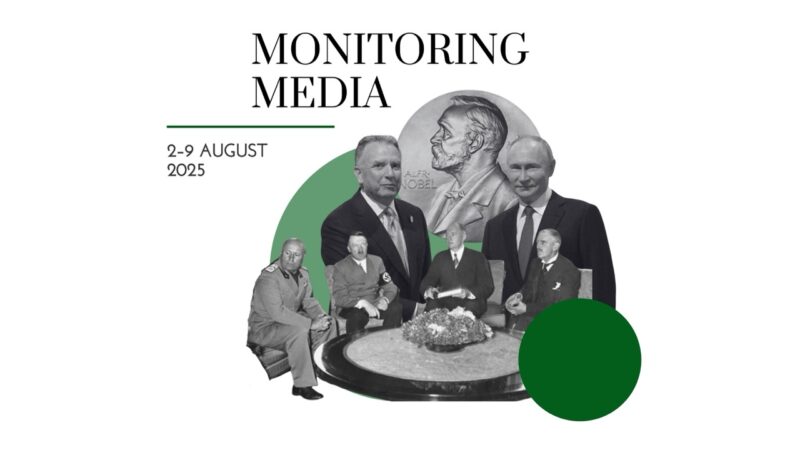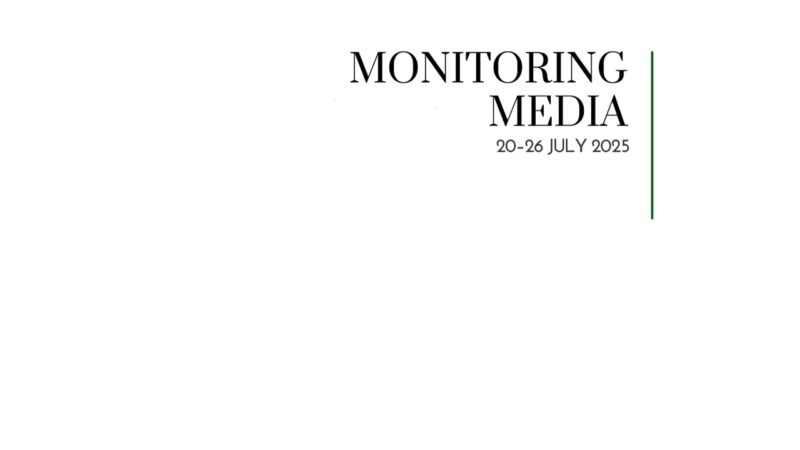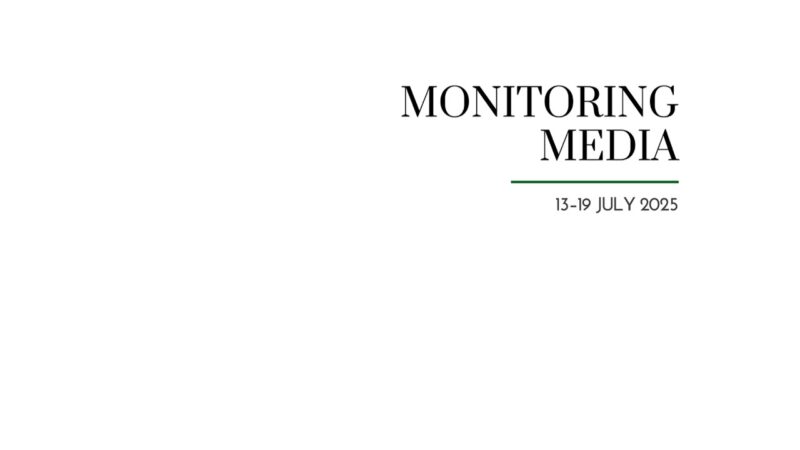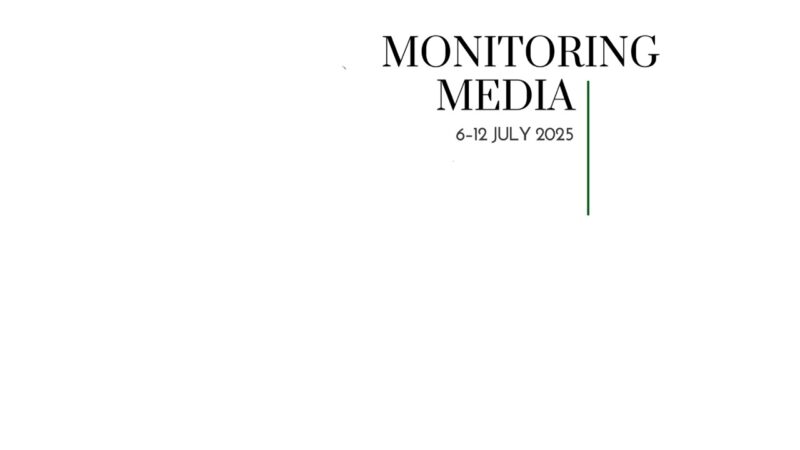Russia has abducted at least 20,000 Ukrainian children

CIUS weekly report on North American media coverage of Ukrainian affairs, 22–28 July 2023
Two publications (Atlantic Council and The National Interest) were selected to prepare this report on how the situation in Ukraine has been portrayed in the North American press during the past week (22–28 July 2023). The sample was compiled based on their impact on public opinion as well as on their professional reputation, popularity among the readership, and topical relevance. These two publications represent centrist and conservative viewpoints on the political spectrum.
This report covers only the most-read and relevant articles about Ukraine, as ranked by the respective North American publications themselves in the past week. Its scope covers promoted articles on home pages and articles from special sections on Ukraine, with the hashtag #Ukraine, from the paper editions of the publications, and about Ukraine from opinion columns and editorials.
Topics featured in the selected articles:
- Ukraine’s current affairs: Ukraine can become a key stakeholder in the EU’s energy security; Ukraine’s Diia is the world’s most advanced e-governance platform; Ukraine’s postwar reconstruction should also accelerate democratization; Ukraine’s fight against corruption should continue regardless of the war;
- The world and Ukraine: the war will end when both Ukraine and Russia reach a stalemate on the battlefield; the US-Israeli security partnership is irrelevant for Ukraine;
- Russia at war: Russia’s abduction of thousands of Ukrainian children is a genocide.
Main arguments:
Ukraine may become a crucial contributor to new energy security architecture in the EU. Sergiy Makogon (Atlantic Council) writes that while the EU states have significantly decreased their dependence on Russian gas, much more can be done to boost their energy security. This includes exploring the opportunities presented by Ukrainian gas storage facilities with an overall capacity of 31 billion cubic metres, the largest in Europe. “These facilities are overwhelmingly concentrated in the west of [Ukraine], far from the present front lines of the Russian invasion and close to the borders with EU member states Poland, Slovakia, Hungary, and Romania.” Makogon narrates the history of how Ukraine’s gas storage facilities were built in the USSR in the 1970s, became a token in the Russian energy wars of the 2010s, and got integrated into the EU’s energy transportation system in the 2020s. Makogon argues that “Ukraine has the potential to distribute up to 200 million cubic meters of gas per day to EU markets.” However, to reach these volumes Ukraine’s storages require even deeper integration into the European energy networks, as well as expansion of its physical capacities within the EU. The latter anticipates, among other things, repurposing German pipelines to transport gas from the country’s LNG terminals in the North Sea to Ukraine, as well as building new pipelines in Poland and Hungary to increase volumes in their gas transit systems. Makogon concludes that the European Commission recognized the strategic significance of Ukraine’s underground gas storage facilities and adds that they “can help Europe cope with any seasonal spikes in demand for gas, but present infrastructure is insufficient. [Increased import capacity to Ukraine’s gas storage facilities] should be viewed as a strategic initiative with the potential to pave the way for a new era of European energy security.”
Ukraine’s Diia e-governance platform sets the benchmark for other countries in the world. Mykhailo Fedorov (Atlantic Council) writes that “despite suffering the horrors and trauma of Russia’s ongoing invasion, Ukrainians continue to open new businesses, get married, pay taxes, and apply for financial assistance from the state. This remarkable resilience has been possible in large part thanks to Ukraine’s digital revolution.” In particular, Fedorov praises the functionality of the Diia app, launched in September 2019. Almost four years later, over 19.2 million Ukrainians have installed it, equal to an approximately 70 percent penetration on the smartphones in the country. The application has increased people’s trust in the digital state and governmental protection of personal data, accelerated the social acceptance of new technologies, and ushered in many bureaucratic simplifications: for example, one can register a vehicle, change residency information, and store electronic passports and driver’s licences on the app. The official government pays much attention to making the app as secure as possible; a team of hackers was hired “to probe the Ukrainian digital systems for weaknesses” and to work with other “hackers around the world with the task of penetrating the Diia platform.” No vulnerabilities were found. Much of the Ukrainian resilience against Russian aggression has been built with the help of Diia. For example, even people in occupied territories can use the app to access government services or read the news. Other countries in the world, such as Estonia (one of the world’s earliest implementers and present leaders in e-governance), was inspired by Ukraine’s Diia and developed their own national version of the program. Fedorov concludes that the app passed the test of the largest European war since 1945 and the first full-scale cyberwar in history: “This achievement should dispel any lingering doubts that governments across the world will all eventually go digital. As they embrace digitalization, other countries can look to Ukraine as a model and as a source of inspiration.”
Ukraine’s postwar reconstruction should embrace political revitalization. Oleksii Antoniuk (Atlantic Council) detects an important blind spot in the discussions about Ukraine’s postwar reconstruction: while the industrial and infrastructural aspects gain everyone’s attention, little is said about the need to repair and strengthen the central pillars of Ukraine’s democracy. Antoniuk highlights that contrary to Russian expectations, upon being invaded Ukrainian state institutions proved to be exceptionally resilient and adaptive. The governance did not crumble under the pressure of the attacking army. However, Ukrainian political parties, local government, civil society, and the media took a heavy toll and will likely emerge weakened after the war is over. This poses a challenge to the continuity of democratic statebuilding and, consequently, to the European and transatlantic integration of Ukraine. Antoniuk writes that when the fighting broke out, Ukrainian NGOs had to switch from thousands of peace-time activities to humanitarian work and defence; political parties suffered much of their regional networks being undermined, which plunged them into major disarray; the executive branch of government took on many of the functions of the legislative branch, which disrupted the system of checks-and-balances; the media stopped being truly independent and joined the government-run “United News” platform to boost the war effort; and local authorities—if not exactly willingly curtailed—did not oppose what had overall been an effective decentralization reform in order to further empower the government in Kyiv. All these developments will need to be undone after the fighting is over. That being said, Antoniuk believes that “the key pillars of Ukraine’s democracy can emerge stronger than ever in the postwar period. Throughout more than three decades of independence, Ukrainians have repeatedly demonstrated their readiness to fight tenaciously for a democratic future.” Apart from that, Ukraine’s Western partners are expected to continue playing a critical role in the country’s political revitalization.
Ukraine should continue its fight against corruption so as to limit Russian influence on domestic politics. Brian Mefford (Atlantic Council) argues that even during wartime, the government in Kyiv should not forget about conducting reforms, particularly to minimize corruption. Medford mentions that regrettably “the multiple anti-corruption agencies established by Ukraine following the country’s 2014 Euromaidan Revolution have yet to bring any high-ranking corrupt officials or oligarchs to justice. Instead, critics claim these agencies are frequently manipulated and weaponized in order to target reformers.” One such reformer who has had his reputation damaged is Volodymyr Omelyan, a former Ukrainian Transportation Minister, who was accused by the Anti-Corruption Bureau of illegally ordering the reduction of all port fees by 20 percent while in office; the accusations were eventually dismissed. Apart from that, anti-corruption institutions do appear to be weaponized in political battles in order to target inconvenient opponents. For instance, Vladyslav Atroshchenko lost his position as the mayor of Chernihiv for using his service car to send his wife to safety in Poland while he stayed to help defend the city. The major of Rivne, Oleksandr Tretyak, was suspended by the court because the National Agency for the Prevention of Corruption issued a protocol “for a technical ‘conflict of interest’ related to the payment of a bonus to an employee who had made a donation to Tretyak’s election campaign some years earlier while working as a campaign volunteer.” Mefford argues that during wartime, when Ukrainians are making sacrifices and resorting to unorthodox measures in order to defend their country, “accusations that anti-corruption agencies are being misused to target reformers and political opponents could have a significant negative impact on morale.” Mefford concludes that regardless of the outcome on the battlefield, Russia will win in Ukraine if the latter continues using corruption as a tool of governance: “Ukrainian victory will only come when both Russia and [Ukraine’s own] corruption are decisively defeated.”
The Russo-Ukrainian war will likely end when both belligerents over-exhaust themselves. Paul R. Pillar (The National Interest), author of the book Negotiating Peace, analyzes Ukraine’s and Russia’s diplomatic and military relations through the prism of bringing the war to an end. He begins by stating that “the ending of the war in Ukraine will almost certainly entail some form of bargaining between Ukraine and Russia, and will leave a situation that represents a compromise between the interests of the two nations.” The compromise will likely be inevitable, he says, because the majority of interstate conflicts end with both belligerents exhausting each other to the extent that further fighting becomes infeasible, yet none of the belligerents are annihilated. In other words, Pillar asserts, a complete victory of Ukraine against Russia is likely impossible; even if it happens, it will likely not discourage Russia from continuing its aggression at every opportunity. Therefore, “even a war that is said to end in a surrender does not involve totally imposing the will of one side on the other and involves a negotiated compromise.” Apart from surrender with opt-outs, another scenario of ending the war resides in the reciprocal withdrawal of the belligerents, “freezing” the conflict, and not signing any peace deal. This scenario appeals to neither Ukraine nor Russia, as without reaching a stalemate, they would naturally be inclined to continue fighting. The author suggests that the “belligerents will [only] become willing to negotiate a peace agreement when they both have demonstrated, to themselves and to the enemy, the limits of what they are able and willing to do militarily, and there is little or no prospect for either side to change the situation on the battlefield appreciably with one more offensive effort.” Pillar refers to numerous examples of earlier wars in Korea, Vietnam, China, and Japan and projects their logic and dynamics on the Russo-Ukrainian confrontation. He concludes that if Ukraine’s counteroffensive fails to bring favourable results, “the bargaining gap that must be bridged is between Ukraine’s disinclination to formally cede any of its territory and Putin’s need to show some gain from his costly military misadventure.”
The security model that the US designed for Israel cannot be copy-pasted to Ukraine. Geoffrey Aronson (The National Interest) opines that “the Israel model is barely relevant to the predicament that Ukraine finds itself in and hardly a good model upon which to build the desired security relationship between the United States, NATO, and Ukraine.” In Aronson’s view, President Biden’s promise during the 2023 NATO Summit in Vilnius to use the Israel model and offer security guarantees to Ukraine is hardly achievable. This promise demonstrates either the President being underinformed about the nature of US-Israeli ties or confusion in Washington about how to construct future US-Ukraine ties. Aronson writes that US support for Israel has been built on three pillars: (1) Cold War competition in the Middle East; (2) Israel’s overwhelming victory in the 1967 Arab-Israeli War; and (3) Israel’s surreptitious development of nuclear weapons capability from the 1950s onward. None of these pillars is present in contemporary Ukraine. Aronson continues that the US deal with Israel has always aimed at assuring the superiority of the latter in conventional weapons against any combination of Arab/Iranian enemies. For that reason, Israel is constantly one the top recipients of US foreign aid: in 2020 Washington provided the government of Israel with $146 billion in military, economic, and missile defence funding, and in 2018 the funding reached a peak of $236 billion. In contrast, Ukraine received $77 billion from the US in the first year of the active fighting, with only one-half of it designated for military, economic, and humanitarian needs. That level of funding helped Ukraine keep the front against Russia, but unlike what is provided to Israel year-in and year-out, it is obviously not enough to push the aggressor back. Another feature that makes the Israeli security model inapplicable to Ukraine is that the former has never intended to join NATO. While Ukraine has been officially seeking membership in the Alliance for two decades already, Israel has consistently opposed any arrangement that would limit its “freedom of action” in the region.
Russia has abducted at least 20,000 Ukrainian children, who are likely undergoing forcible indoctrination. Vladyslav Havrylov (Atlantic Council) is one of the many legal experts who argue that Russia’s mass abduction of Ukrainian children qualifies as genocide. The abductions have already resulted in numerous troubles for Kremlin leaders, including warrants issued by the International Criminal Court for President Putin and for Russia’s Commissioner for Children’s Rights Lvova-Belova, the threat of arrest effectively preventing them from travelling outside of Russia—not to mention the public humiliation of Putin and his discredited authority on domestic and international levels. To counter the scrutiny and opprobrium, the Kremlin persists in portraying the abduction and relocation of Ukrainian children to Russia as a forced yet legal measure to save their lives and health. Yet evidence collected on the fates of Ukrainian children in Russia and their subsequent indoctrination contradicts Moscow’s statements: “A February 2023 report published by the Yale School of Public Health identified a large-scale Russian initiative to re-educate thousands of abducted Ukrainian children via a network of more than 40 camps and facilities stretching from Russian-occupied Crimea to Siberia.” Havrylov writes that the exact number of children abducted to Russia remains unknown. According to conservative calculations of the Ukrainian side, there are at least 20,000, that number being with actual identified names. However, there are fears that the true total number may be far higher. Efforts to rescue Ukrainian children taken to Russia are now gaining momentum, but so far only a few hundred abductees have been returned to Ukraine. Havrylov concludes with the news that in April 2023 PACE (Parliamentary Assembly of the Council of Europe) passed a resolution officially recognizing the deportation of Ukrainian children to Russia as a genocide. This resolution did not go unnoticed and has since influenced the official rhetoric of US, UK, and Ukrainian officials.





